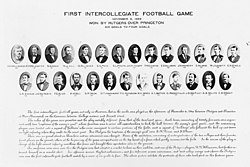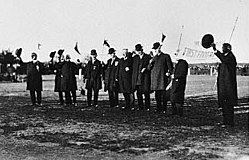1869 Princeton vs. Rutgers football game
| First College Football Game Princeton at Rutgers | ||||||||||
|---|---|---|---|---|---|---|---|---|---|---|
| ||||||||||
| ||||||||||
| Date | November 6, 1869 | |||||||||
| Season | 1869 | |||||||||
| Location | New Brunswick, New Jersey | |||||||||
| Attendance | 100 | |||||||||
The 1869 Princeton vs. Rutgers football game was played between Princeton and Rutgers on November 6, 1869. The rules governing play were based on the London-based Football Association's 1863 rules that disallowed carrying or throwing the ball.[1][2][3][4][5]
Additionally, because gridiron football developed from the rules of association football and rugby football, many also consider the game played on November 6 to be the first gridiron game and the first collegiate American football game.[6] Rutgers won the game 6–4.[7]
| Part of the American football series on the |
| History of American football |
|---|
| Origins of American football |
| Close relations to other codes |
| Topics |
Details
Part of the first season of college football, the game took place on November 6, 1869 at a field on College Avenue (now the site of the College Avenue Gymnasium) in New Brunswick, New Jersey.[8] Because the game was played at Rutgers, it was also played under Rutgers' rules. They were based on the Football Association's rules of the time, in which two teams of 25 players attempted to score by kicking the ball into the opposing team's goal. The teams played 10 "games" against each other. When a team scored a goal, it counted as the end of that game, and the team with the most goals after 10 games was the winner.[9] It is clear that this format did not resemble the game of college football as known today.[10] The first such game in the United States in which the ball is advanced by physically picking it up and running, where play is stopped by knocking down the ball carrier, and each team fields eleven members was played on June 4, 1875 between Tufts and Harvard colleges.[11] and then Yale on November 13. That game caused Yale to drop association football in favor of rugby.[10]
William J. Leggett, later a distinguished clergyman of the Dutch Reformed Church, was the Rutgers captain; William Gummere, who later became chief justice of the Supreme Court of New Jersey, captained the New Jersey squad.[9] The game was played in front of approximately 100 spectators.[12] The players from Rutgers wore scarlet-colored turbans and handkerchiefs to distinguish themselves from the Princeton players. The scarlet of the Rutgers Scarlet Knights came from this episode.[13]
Rules
The rules for this game –the first code for any form of football in the United States– were as follows:[14]
- Grounds must be 360 feet (110 m) long and 225 feet (69 m) wide.
- Goals must be 8 paces.
- Each side shall number 25 players.
- No throwing or running with the ball. if either it is a foul and the ball then must be thrown perpendicularly in the air by the side causing the foul.
- No holding the ball or free kicks allowed.
- A ball passing beyond the limit on the side of the goal shall be kicked on from the boundary by the side who was that goal.
- A ball passing the limit on the side of the field shall be kicked on horizontally to the boundary by the side which kicked it out.
- No tripping or holding of players.
- The winner of the first toss has the choice of position; the winner of the second toss has the first kick-off.
- There shall be four judges and two referees.
Gameplay

As the first of the 10 games began, two players from each of the teams positioned themselves near the opponent's goal. This was presumably because the participants were hoping to easily score when the ball reached their territory on the field of play. On each team, there were eleven so-called "fielders" who were assigned to defend their own territorial area. There were 12 participants on each team that they named "bulldogs" who were the ones playing in the other team's territory.[15][14]
Rutgers was the first to score a goal, as S. G. Gano and G. R. Dixon successfully kicked the ball across the Princeton goal. At some point early in the contest, the "flying wedge" play was first used as the team with the ball formed a wall-like formation of players, allowing them to charge at the defenders. This flying wedge tactic was successful early on for Rutgers because of their size disadvantage over Princeton. However, Princeton countered the tactic when J.E. Michael, better known as "Big Mike", broke up the Rutgers' flying wedge during the fourth game. Princeton took advantage and tied the score at 2–2.[16]

A Rutgers player named Madison M. Ball, a wounded veteran of the American Civil War, used his quickness and kicking the ball with the heel of his foot to again take the lead in the contest.[17] Whenever the ball entered Rutgers territory, Ball would get in front of it and use a heel-kick to prevent Princeton from scoring. Ball was able to successfully use that technique to set up Dixon to score another goal which gave Rutgers a 4–2 lead. Rutgers then allowed Princeton to score a goal as one of their players, whose identity is not known, had kicked a ball toward their own goal. It was blocked by a Rutgers player, but Princeton soon was able to take advantage to cut the lead down to 4–3. The Tigers scored on their next possession when they used a flying wedge play of their own led by Big Mike to march down the field to score to tie the game again at 4.[14]
Rutgers captain John W. Leggett had a strategy for his team at this point. He suggested that the Rutgers team keep the ball low on the ground to counter the much taller players on Princeton. This strategy appeared to work as Rutgers easily scored the final two goals of the contest to win the first intercollegiate football game played 6 games to 4.[14]
Princeton had more size, which would normally be an advantage on a field with 50 total players, but the Tigers had trouble kicking the ball as a team which is something Rutgers did very well. In a 1933 account, a Rutgers player from the game named John W. Herbert said that he thought Rutgers was the smaller team, but that they had more speed than Princeton .[12]
Reports

To appreciate this game to the full you must know something of its background," (...) "The two colleges were, and still are, of course, about 20 miles apart. The rivalry between them was intense. For years each had striven for possession of an old Revolutionary cannon, making night forays and lugging it back and forth time and again. Not long before the first football game, the canny Princetonians had settled this competition in their own favor by ignominiously sinking the gun in several feet of concrete. In addition to this, I regret to report, Princeton had beaten Rutgers in baseball by the harrowing score of 40-2. Rutgers longed for a chance to square things."
— Rutgers' John W. Herbert, 1933 [18]
"In every game the cool goaltenders saved the Rutgers goal half a dozen times; in every game the heavy charger of the Princeton side overthrew everything he came in contact with; and in every game, just when the interest in one of those delightful rushes at the fence was culminating, the persecuted ball would fly for refuge into the next lot, and produce cessation of hostilities until, after the invariable 'foul', it was put in straight (...) "To sum up, Princeton had the most muscle, but didn't kick very well, and wanted organization. They evidently don't like to kick the ball on the ground. Our men, on the other hand, though comparatively weak, ran well, and kicked well throughout. But their great point was the organization, for which great praise is due to the captain. The right men were always in the right place."[18]
— match report at The Targum, Rutgers' undergraduate newspaper - Nov 1869
Aftermath
In what might be considered a beginning to college football rivalries, immediately after Rutgers won this game, Princeton's players were literally run out of town by the winning Rutgers students. The Princeton students reportedly jumped in their carriages and quickly made the 20-mile trip back to their campus.[9]
Fifty years after the historic first game, members of the 1869 Rutgers football team were honored at Homecoming ceremonies in 1918.[18]
The last surviving player of Princeton, Robert Preston Lane (b. 1851) died in November 1938, while the last surviving Rutgers player, George H. Large (b. 1850) died in 1939.[18]
In 1968, Arnold Friberg was commissioned by Chevrolet to create a painting commemorating the game. His work The First Game was one of four works that he created to celebrate 100 years of college football.[19]
References
- ^ Best of the 1870s: The defining players and teams of college football’s first decade by Matt Brown on The Athletic, January 28, 2019
- ^ America and the 1863 Football Association Code by Melvin Smith on Society for American Soccer History, 6 Oct 2015
- ^ "U.S. Soccer Timeline". U.S. Soccer. Retrieved June 23, 2020.
- ^ Wangerin, David (2008). Soccer in a football world : the story of America's forgotten game. Philadelphia: Temple University Press. ISBN 978-1-59213-885-2. Retrieved June 23, 2020.
- ^ Allaway, Roger (March 26, 2001). "West Hudson: A Cradle of American Soccer". ussoccerhistory.org. Retrieved July 29, 2024.
- ^ Richmond, Sam (November 6, 2019). "1st college football game ever was New Jersey vs. Rutgers in 1869". NCAA. Retrieved June 23, 2020.
- ^ "1869 Princeton Tigers Schedule and Results". SR/College Football. Sports Reference LLC. Retrieved February 27, 2017.
- ^ "Our History – Rutgers 250". Rutgers University. Retrieved December 27, 2017.
- ^ a b c "Rutgers Scarlet Knights Face of the Program". ESPN. Retrieved December 26, 2017.
- ^ a b THE BOSTON GAME article by Michael T. Geary at academia.edu
- ^ "THE FOOTBALL H: A CRIMSON H ON A BLACK SWEATER The H Book Of Harvard Athletics 1852 1922 (archived, August 21, 2010)
- ^ a b Hyman, Vicki (October 23, 2010). "How New Jersey Saved Civilization... the first intercollegiate football game". NJ.com. Retrieved December 27, 2017.
- ^ "Rutgers Traditions". Rutgers University. Retrieved December 27, 2017.
- ^ a b c d Twenty-four stalwart men, and a goliath from an article by Parke H. Davis '93 on University of Princeton blog
 This article incorporates text from this source, which is in the public domain.
This article incorporates text from this source, which is in the public domain.
- ^ Pellowski, Michael J (2007). "Part One 1869–1949" (PDF). Rutgers Football: A Gridiron Tradition in Scarlet. Rutgers University. Archived from the original (PDF) on March 13, 2012.
- ^ David J. Warner (September 9, 2006). "Good morning, class, and welcome to Football History 101". Fanhouse.com. Archived from the original on January 16, 2013.
- ^ Glazer, Steven D. (2014). "Rutgers in the Civil War". Journal of the Rutgers University Libraries. 66: 99, 120. doi:10.14713/jrul.v66i0.1865.
- ^ a b c d The first game at Rutgers (archived, October 4, 2017)
- ^ Scott, Ricahrd (2008). "Chapter 2". SEC Football: 75 Years of Pride and Passion. Voyageur Press. p. 42. ISBN 978-1-61673-133-5.


